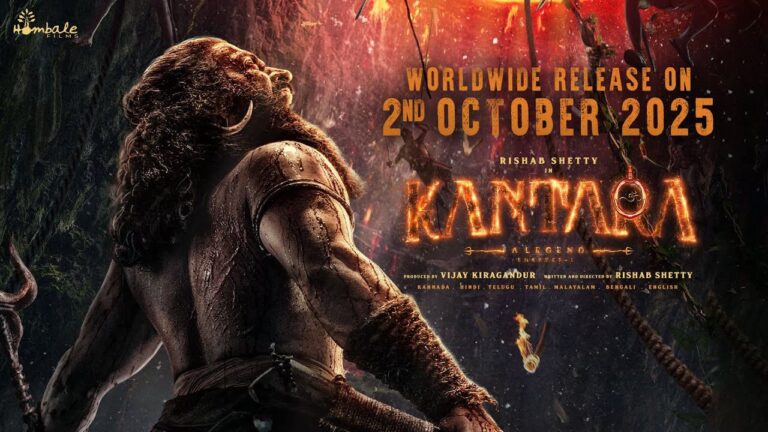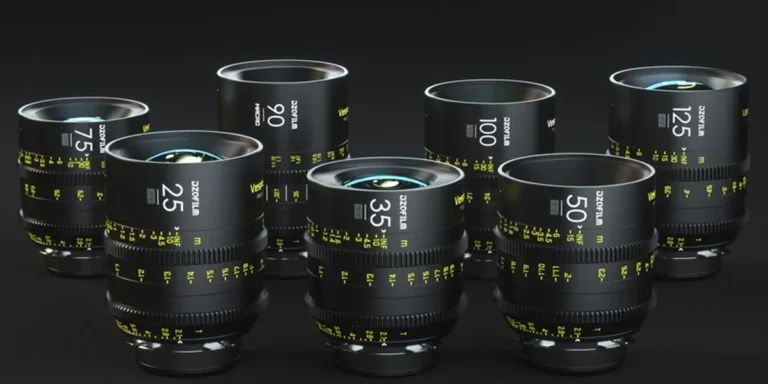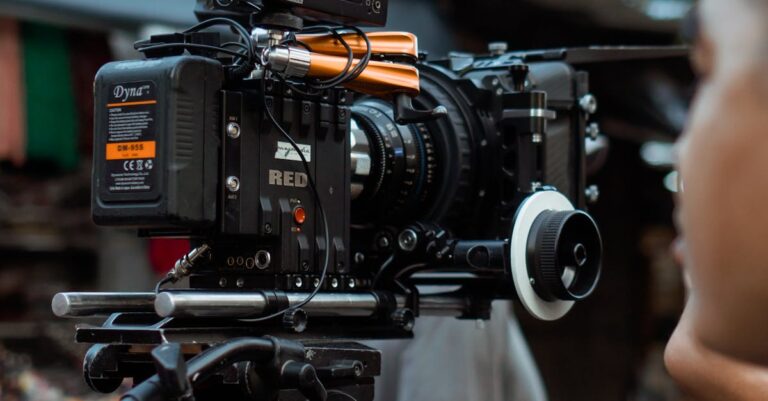
Of all the cinematic triumphs to emerge from India in recent years, few have captured the raw, earthy spirit of their homeland quite like Rishab Shetty’s Kantara. For the team at Thiraimozhi.com, where we celebrate the art of visual storytelling, the film’s opening chapter is a particular masterclass. It’s a powerful lesson in how to build a world without lengthy exposition, instead using pure, visceral filmmaking to hook an audience from the very first frame.
This analysis delves into the filmmaking genius of Kantara‘s first chapter, exploring the techniques that make it so compelling for aspiring filmmakers and cinephiles.
A World Built on Atmosphere, Not Dialogue
The 19th-century prologue immediately immerses us. The cinematography is intentionally gritty and textured. You feel the oppressive humidity of the forest and see the world through a haze of smoke and dust. The reliance on natural, flickering light sources—from torches to the dim forest canopy—creates a profound authenticity. This isn’t a glossy period piece; it’s a living, breathing, and intimidating ecosystem established through the lens.
Sound as a Narrative Engine
For any film student, the sound design in Kantara Chapter 1 is a benchmark. The rhythmic, primal beats of the Bhootha Kola drums are not mere background score; they are the narrative’s pulsating heartbeat. The chants, the unsettling silence, and the rustle of unseen forces build a tangible suspense. This auditory landscape masterfully establishes the core theme: the fragile pact between man and the divine, and the peril of disrupting that balance.

The Power of Physical Performance
The performances are a testament to show-don’t-tell. Rishab Shetty, as the Panjurli Daiva, delivers a terrifying transformation during the Kola. This isn’t achieved with CGI, but through raw, uninhibited physicality and a gaze that chills to the bone. It’s a performance that commands belief, making the mythological stakes feel immediate and visceral.
In conclusion, the first chapter of Kantara is a formidable piece of cinema. It roots a grand, spiritual conflict in the mud and soil of a specific culture, trusting the audience to understand through sensation and image. For readers of Thiraimozhi.com, it serves as a stunning reminder of filmmaking’s fundamental power: to show, not just tell.
Tamil
இது நீங்கள் கேட்ட உரையின் தமிழாக்கம் — செம்மையாகவும் இலக்கியநயமுள்ள பாணியிலும் வடிவமைக்கப்பட்டுள்ளது, Thiraimozhi.com போன்ற சினிமா இலக்கிய இணையத்தளத்திற்குத் தகுந்ததாகவும் இருக்கிறது:
கந்தாரா – ஒரு காட்சிச் சாகாவதியின் முதல் அத்தியாயம்
கடந்த சில ஆண்டுகளில் இந்தியாவில் உருவாகியுள்ள சினிமா வெற்றிகளில், தாய்மண்ணின் மண்ணணந்த உணர்வையும் இயற்கையின் உள்மூச்சையும் இப்படிச் சிறப்பாகப் பதிவு செய்த திரைப்படங்கள் மிகச் சிலவே உள்ளன. ரிஷப் ஷெட்டியின் கந்தாரா அவற்றில் முதன்மையானது. காட்சிக் கதையாட்டத்தின் கலைக்கு அர்ப்பணிக்கப்பட்ட Thiraimozhi.com குழுவிற்கு, இப்படத்தின் முதல் அத்தியாயம் ஒரு பாடசாலை போன்றது. நீளமான விளக்க உரைகளின்றி, தூய காட்சியியல் அனுபவத்தின் மூலம் உலகை உருவாக்கும் திறனை இப்படம் காட்டுகிறது — முதல் ஃப்ரேமிலேயே பார்வையாளரை தன் கட்டுப்பாட்டுக்குள் கொண்டு வருகின்றது.
இந்த விமர்சனம், கந்தாராவின் முதல் அத்தியாயத்தின் காட்சியமைப்பையும், அதன் பின்புல நுண்ணறிவையும் ஆராய்கிறது — புதிய திரைப்பட இயக்குநர்களுக்கும் சினிமா ஆர்வலர்களுக்கும் ஒரு பாடமாக.
உரையல்ல, சூழலே பேசும் உலகம்
19ஆம் நூற்றாண்டை அடிப்படையாகக் கொண்ட தொடக்கப்பகுதி, நம்மை உடனடியாக அந்த காலத்திற்குள் இழுக்கிறது. ஒளிப்பதிவு மண்ணின் உணர்வைத் தந்துகொள்கிறது — காடின் ஈரமான காற்றையும் புகையும் தூசியும் கலந்த அந்தக் காட்சியையும் நம்மால் உணர முடிகிறது. மின்விளக்குகள், தீப்பந்தங்கள், காடு மெல்லப் புகும் ஒளி — இவை அனைத்தும் இயற்கை வெளிச்சத்தின் நம்பிக்கையுடன் காட்சியளிக்கின்றன. இது ஒரு பிரம்மாண்ட வரலாற்றுப் படம் அல்ல; மாறாக, உயிரோடு சுவாசிக்கும், கடினமான இயற்கை உலகை ஒரு லென்ஸ் வழியாக நிறுவுகிறது.

ஒலி – ஒரு கதை சொல்லும் இயந்திரம்
கந்தாரா – அத்தியாயம் 1 படத்தின் ஒலி வடிவமைப்பு, எந்த திரைப்படக் கல்லூரியிலும் கற்பிக்கத்தக்க ஒரு எடுத்துக்காட்டு. பூதகோலத்தின் தாளங்கள் வெறும் பின்னணிச் சத்தமல்ல; அவை கதையின் துடிக்கும் இதயம். மந்திர ஓசைகள், இடையிடையே வரும் அமைதி, காடின் அறியப்படாத உயிர்களின் அசைவுகள் – இவை அனைத்தும் ஒன்றிணைந்து அச்சமூட்டும் உணர்வை உருவாக்குகின்றன. இந்த ஒலி உலகம், மனிதனுக்கும் தெய்வத்திற்கும் இடையிலான நுட்பமான சமநிலையை நினைவூட்டுகிறது — அதை உடைப்பதன் ஆபத்தை வெளிப்படுத்துகிறது.
உடல் மொழியின் ஆற்றல்
இப்படத்தில் நடிப்பு “சொல்லாமல் காட்டுதல்” என்ற கலைக்கு ஒரு சான்று. ரிஷப் ஷெட்டி, பஞ்சுர்லி தெய்வமாக மாறும் தருணங்களில், முழுமையான உடல் மற்றும் ஆன்ம நெருக்கத்துடன் நடிக்கிறார். இது கணினி விளைவுகளால் அல்ல, ஆனால் அவரது உடலின் ஆற்றல் மற்றும் கண்களில் எரியும் தீயால் உருவாகும் தெய்வீக மாற்றம். அந்தக் கணம் நம்மை நடுங்கச் செய்கிறது, நம்பச்செய்கிறது.
முடிவுரை
கந்தாராவின் முதல் அத்தியாயம் ஒரு ஆழமான சினிமா அனுபவம். இது ஆன்மிகப் போராட்டத்தை மண்ணின் வாசத்திலும் கலாச்சாரத்தின் உடம்பிலும் பதித்து வெளிப்படுத்துகிறது. Thiraimozhi.com வாசகர்களுக்கு, இது ஒரு நினைவூட்டல்: சினிமாவின் உண்மையான சக்தி — “சொல்லுவதில்” அல்ல, “காட்டுவதில்தான்” இருக்கிறது.








